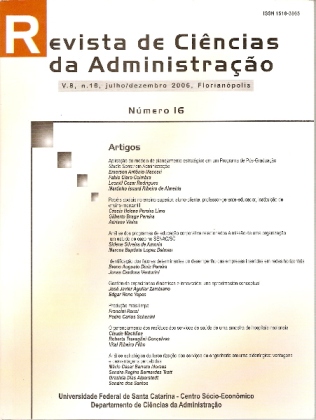Gestión de capacidades dinámicas e innovación: una aproximación conceptual
DOI:
https://doi.org/10.5007/%25xResumo
Las capacidades empresariales corresponden a aquellas rutinas de tipo comportamental que definen lo que las empresas realizan para desarrollar una tarea específica (NELSON; WINTER, 1982). Esto define lo que la empresa sabe hacer y cómo lo debe hacer. Sin embargo, el carácter recurrente de estas capacidades, puede generar estancamientos en el desarrollo estratégico competitivo de las organizaciones, ya que al generar recurrencia, se condiciona a que el aprendizaje se detenga (METCALFE, 1995), lo cual limita la generación de nuevas capacidades al disminuir el dinamismo en la producción, reproducción y reconfiguración de las rutinas que las conforman (TEECE; PISANO; SHUEN, 1997). Este artículo compara y analiza diferentes perspectivas teórico-conceptuales que sustentan la producción y reconfiguración de capacidades tecnológicas al interior de una organización y plantea algunas propuestas sobre el análisis, desempeño y creación de nuevas capacidades, que posibiliten procesos de innovación al interior de las organizaciones. Para ello, se utilizará el concepto de capacidades dinámicas y se revisará su papel como habilitador o conductor de cambios en la organización. La mirada de las capacidades dinámicas permite aproximarse y tratar de entender la complejidad de la creación, desarrollo y uso de capacidades, y el papel que juegan en la práctica. Este entendimiento podría constituir material fundamental para gestionar procesos de aprendizaje y cambio organizacional y propiciar la capacidad de innovación.Downloads
Publicado
Como Citar
Edição
Seção
Licença
O autor deve garantir:
- que haja um consenso completo de todos os coautores em aprovar a versão final do documento e sua submissão para publicação.
- que seu trabalho é original, e se o trabalho e/ou palavras de outras pessoas foram utilizados, estas foram devidamente reconhecidas.
Plágio em todas as suas formas constituem um comportamento antiético de publicação e é inaceitável. RCA reserva-se o direito de usar software ou quaisquer outros métodos de detecção de plágio.
Todas as submissões recebidas para avaliação na revista RCA passam por identificação de plágio e autoplágio. Plágios identificados em manuscritos durante o processo de avaliação acarretarão no arquivamento da submissão. No caso de identificação de plágio em um manuscrito publicado na revista, o Editor Chefe conduzirá uma investigação preliminar e, caso necessário, fará a retratação.
Os autores cedem à RCA os direitos exclusivos de primeira publicação, com o trabalho simultaneamente licenciado sob a Licença Creative Commons (CC BY) 4.0 Internacional.

Os autores têm autorização para assumir contratos adicionais separadamente, para distribuição não exclusiva da versão do trabalho publicada neste periódico (ex.: publicar em repositório institucional, em site pessoal, publicar uma tradução, ou como capítulo de livro), com reconhecimento de autoria e publicação inicial neste periódico.
Esta licença permite que qualquer usuário tenha direito de:
Compartilhar – copiar, baixar, imprimir ou redistribuir o material em qualquer suporte ou formato.
Adaptar – remixar, transformar e criar a partir do material para qualquer fim, mesmo que comercial.
De acordo com os seguintes termos:
Atribuição – Você deve dar o crédito apropriado (citar e referenciar), prover um link para a licença e indicar se mudanças foram feitas. Você deve fazê-lo em qualquer circunstância razoável, mas de maneira alguma que sugira ao licenciante apoiar você ou o seu uso.
Sem restrições adicionais – Você não pode aplicar termos jurídicos ou medidas de caráter tecnológico que restrinjam legalmente outros de fazerem algo que a licença permita.


